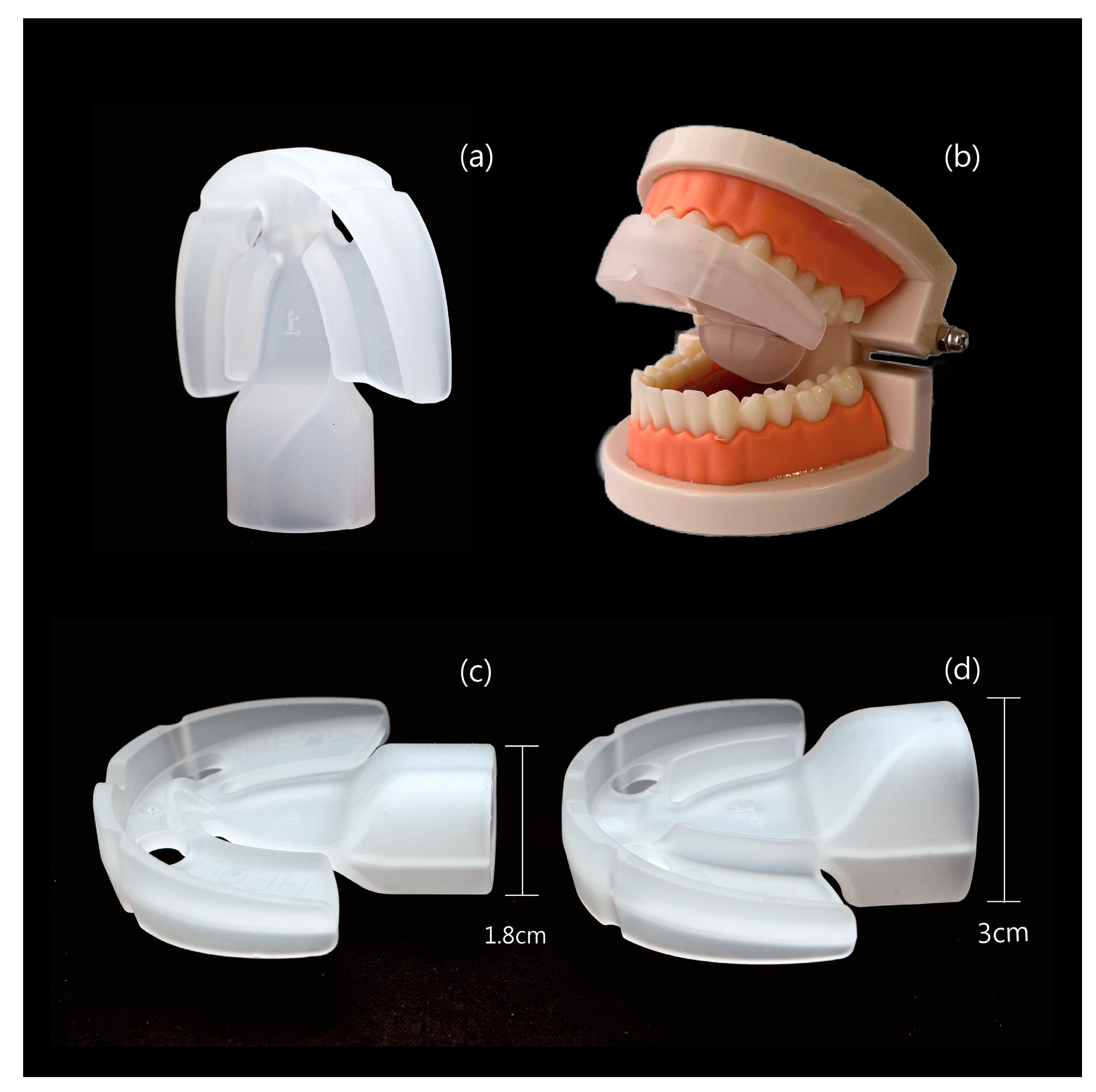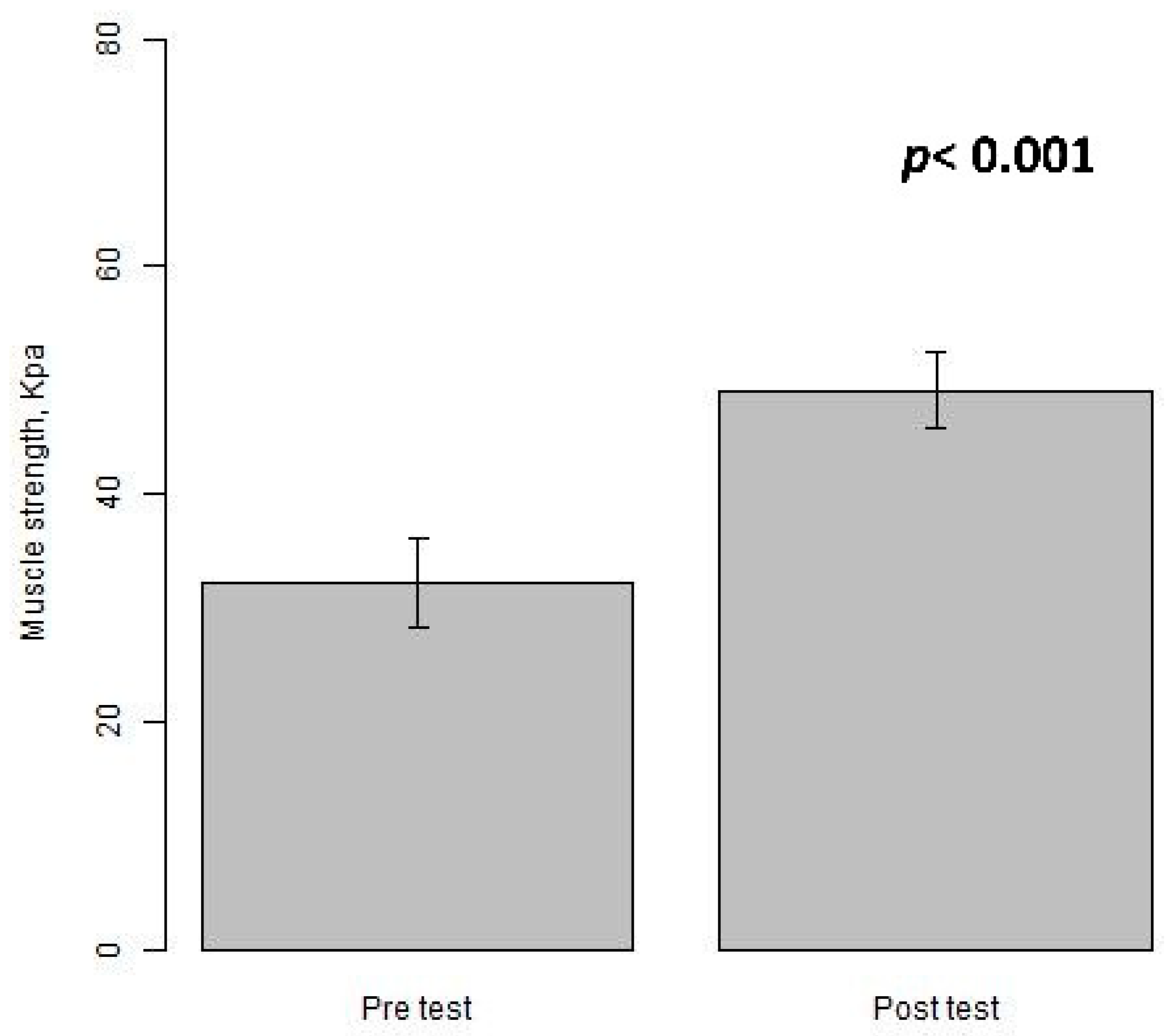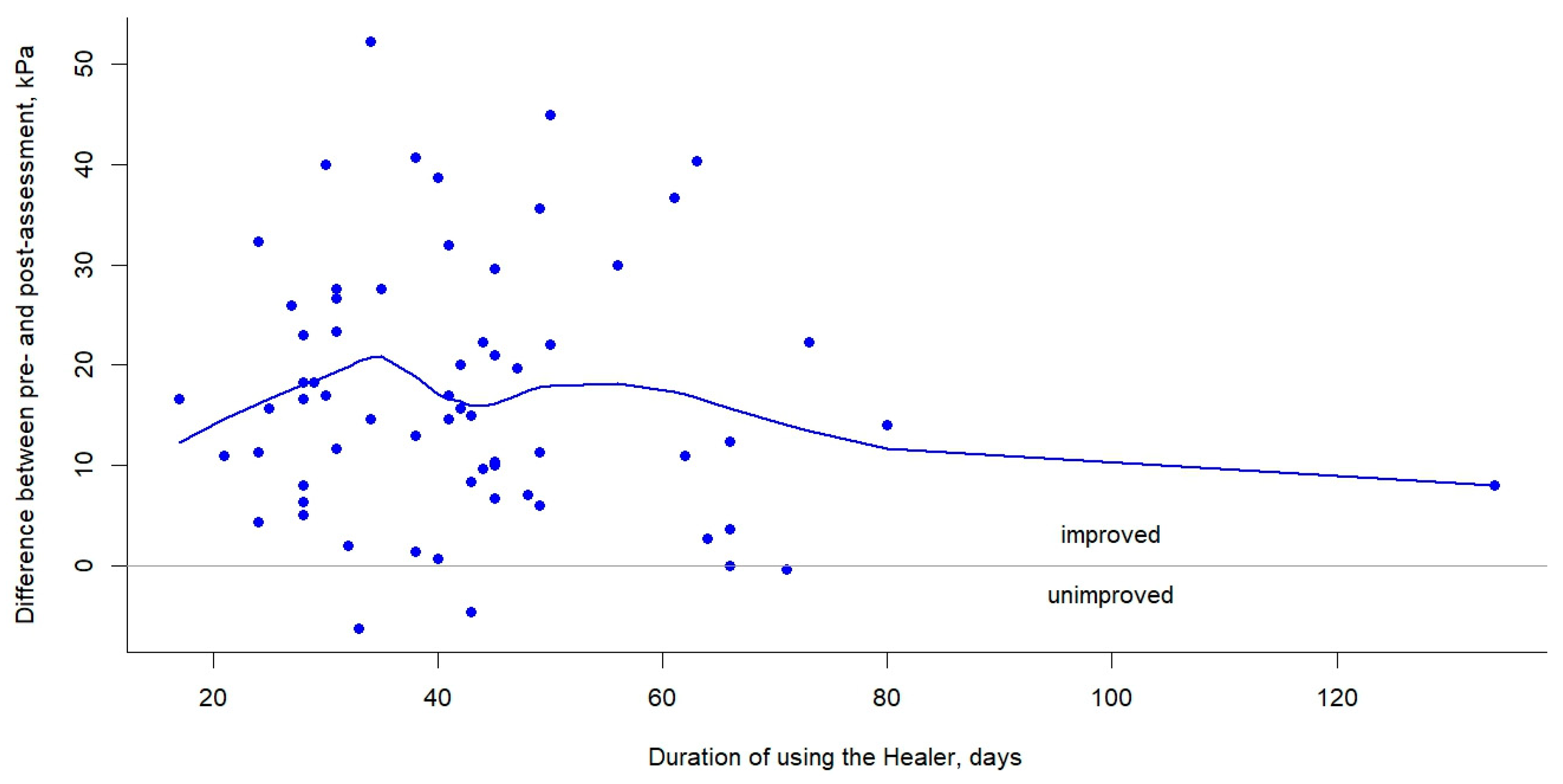The Impact of a Tongue Training Device on Tongue Muscle Strength in Patients with Obstructive Sleep Apnea After Modified Uvulopalatopharyngoplasty: A Pilot Study
Abstract
1. Introduction
2. Materials and Methods
2.1. Study Design
2.2. Study Population
2.3. Interventions
2.4. Outcome Measures
2.5. Statistical Analysis
3. Results
4. Discussion
5. Conclusions
Author Contributions
Funding
Institutional Review Board Statement
Informed Consent Statement
Data Availability Statement
Acknowledgments
Conflicts of Interest
Abbreviations
| BQ | Berlin Questionnaire |
| CPAP | Continuous positive airway pressure |
| EAT-10 | The 10-item Eating Assessment Tool |
| ENT | Ear, nose, and throat |
| IOPI | Iowa Oral Performance Instrument |
| OMT | Orofacial myofunctional therapy |
| OSA | Obstructive sleep apnea |
| UPPP | Uvulopalatopharyngoplasty |
References
- Steele, C.M.; Bayley, M.T.; Peladeau-Pigeon, M.; Nagy, A.; Namasivayam, A.M.; Stokely, S.L.; Wolkin, T. A Randomized Trial Comparing Two Tongue-Pressure Resistance Training Protocols for Post-Stroke Dysphagia. Dysphagia 2016, 31, 452–461. [Google Scholar] [CrossRef] [PubMed]
- Robbins, J.; Kays, S.A.; Gangnon, R.E.; Hind, J.A.; Hewitt, A.L.; Gentry, L.R.; Taylor, A.J. The effects of lingual exercise in stroke patients with dysphagia. Arch. Phys. Med. Rehabil. 2007, 88, 150–158. [Google Scholar] [CrossRef] [PubMed]
- Steele, C.M.; Bailey, G.L.; Polacco, R.E.; Hori, S.F.; Molfenter, S.M.; Oshalla, M.; Yeates, E.M. Outcomes of tongue-pressure strength and accuracy training for dysphagia following acquired brain injury. Int. J. Speech Lang. Pathol. 2013, 15, 492–502. [Google Scholar] [CrossRef] [PubMed]
- O’Day, C.; Frank, E.; Montgomery, A.; Nichols, M.; McDade, H. Repeated tongue and hand strength measurements in normal adults and individuals with Parkinson’s disease. Int. J. Orofac. Myol. 2005, 31, 15–25. [Google Scholar] [CrossRef]
- de Felicio, C.M.; da Silva Dias, F.V.; Trawitzki, L.V.V. Obstructive sleep apnea: Focus on myofunctional therapy. Nat. Sci. Sleep 2018, 10, 271–286. [Google Scholar] [CrossRef]
- Poncin, W.; Willemsens, A.; Gely, L.; Contal, O. Assessment and rehabilitation of tongue motor skills with myofunctional therapy in obstructive sleep apnea: A systematic review and meta-analysis. J. Clin. Sleep Med. 2024, 20, 1535–1549. [Google Scholar] [CrossRef]
- Lai, Y.J.; Li, C.Y.; Hung, C.H.; Lin, C.Y. Severity of tongue base collapse in various body positions in patients with obstructive sleep apnea: A trajectory analysis. J. Formos. Med. Assoc. 2024, 123, 1175–1181. [Google Scholar] [CrossRef]
- Poncin, W.; Correvon, N.; Tam, J.; Borel, J.C.; Berger, M.; Liistro, G.; Mwenge, B.; Heinzer, R.; Contal, O. The effect of tongue elevation muscle training in patients with obstructive sleep apnea: A randomised controlled trial. J. Oral Rehabil. 2022, 49, 1049–1059. [Google Scholar] [CrossRef]
- Kapur, V.K.; Auckley, D.H.; Chowdhuri, S.; Kuhlmann, D.C.; Mehra, R.; Ramar, K.; Harrod, C.G. Clinical Practice Guideline for Diagnostic Testing for Adult Obstructive Sleep Apnea: An American Academy of Sleep Medicine Clinical Practice Guideline. J. Clin. Sleep Med. 2017, 13, 479–504. [Google Scholar] [CrossRef]
- Askland, K.; Wright, L.; Wozniak, D.R.; Emmanuel, T.; Caston, J.; Smith, I. Educational, supportive and behavioural interventions to improve usage of continuous positive airway pressure machines in adults with obstructive sleep apnoea. Cochrane Database Syst. Rev. 2020, 4, CD007736. [Google Scholar] [CrossRef]
- Adams, V.; Mathisen, B.; Baines, S.; Lazarus, C.; Callister, R. A systematic review and meta-analysis of measurements of tongue and hand strength and endurance using the Iowa Oral Performance Instrument (IOPI). Dysphagia 2013, 28, 350–369. [Google Scholar] [CrossRef] [PubMed]
- HEAL. 2025. Available online: https://www.healwell.com.tw/about/1.htm (accessed on 2 February 2025).
- Tan, A.; Yin, J.D.; Tan, L.W.; van Dam, R.M.; Cheung, Y.Y.; Lee, C.H. Using the Berlin Questionnaire to Predict Obstructive Sleep Apnea in the General Population. J. Clin. Sleep Med. 2017, 13, 427–432. [Google Scholar] [CrossRef]
- Belafsky, P.C.; Mouadeb, D.A.; Rees, C.J.; Pryor, J.C.; Postma, G.N.; Allen, J.; Leonard, R.J. Validity and reliability of the Eating Assessment Tool (EAT-10). Ann Otol Rhinol Laryngol 2008, 117, 919–924. [Google Scholar] [CrossRef] [PubMed]
- Hagg, M.; Larsson, B. Effects of motor and sensory stimulation in stroke patients with long-lasting dysphagia. Dysphagia 2004, 19, 219–230. [Google Scholar] [CrossRef] [PubMed]
- McCullough, G.H.; Kamarunas, E.; Mann, G.C.; Schmidley, J.W.; Robbins, J.A.; Crary, M.A. Effects of Mendelsohn maneuver on measures of swallowing duration post stroke. Top. Stroke Rehabil. 2012, 19, 234–243. [Google Scholar] [CrossRef]
- Fujiwara, S.; Ono, T.; Minagi, Y.; Fujiu-Kurachi, M.; Hori, K.; Maeda, Y.; Boroumand, S.; Nitschke, I.; Ursula, V.; Bohlender, J. Effect of supraglottic and super-supraglottic swallows on tongue pressure production against hard palate. Dysphagia 2014, 29, 655–662. [Google Scholar] [CrossRef]
- Kim, H.D.; Choi, J.B.; Yoo, S.J.; Chang, M.Y.; Lee, S.W.; Park, J.S. Tongue-to-palate resistance training improves tongue strength and oropharyngeal swallowing function in subacute stroke survivors with dysphagia. J. Oral Rehabil. 2017, 44, 59–64. [Google Scholar] [CrossRef]
- Ra, J.Y.; Hyun, J.K.; Ko, K.R.; Lee, S.J. Chin tuck for prevention of aspiration: Effectiveness and appropriate posture. Dysphagia 2014, 29, 603–609. [Google Scholar] [CrossRef]
- Logemann, J.A.; Kahrilas, P.J.; Kobara, M.; Vakil, N.B. The benefit of head rotation on pharyngoesophageal dysphagia. Arch. Phys. Med. Rehabil. 1989, 70, 767–771. [Google Scholar]
- Clark, H.M.; Shelton, N. Training effects of the effortful swallow under three exercise conditions. Dysphagia 2014, 29, 553–563. [Google Scholar] [CrossRef]
- Hegland, K.W.; Bolser, D.C.; Davenport, P.W. Volitional control of reflex cough. J. Appl. Physiol. (1985) 2012, 113, 39–46. [Google Scholar] [CrossRef] [PubMed]
- Lin, C.J.; Lee, Y.S.; Hsu, C.F.; Liu, S.J.; Li, J.Y.; Ho, Y.L.; Chen, H.H. Effects of tongue strengthening exercises on tongue muscle strength: A systematic review and meta-analysis of randomized controlled trials. Sci. Rep. 2022, 12, 10438. [Google Scholar] [CrossRef] [PubMed]
- Park, J.S.; Kim, H.J.; Oh, D.H. Effect of tongue strength training using the Iowa Oral Performance Instrument in stroke patients with dysphagia. J. Phys. Ther. Sci. 2015, 27, 3631–3634. [Google Scholar] [CrossRef]
- Lazarus, C.L.; Husaini, H.; Falciglia, D.; DeLacure, M.; Branski, R.C.; Kraus, D.; Lee, N.; Ho, M.; Ganz, C.; Smith, B.; et al. Effects of exercise on swallowing and tongue strength in patients with oral and oropharyngeal cancer treated with primary radiotherapy with or without chemotherapy. Int. J. Oral Maxillofac. Surg. 2014, 43, 523–530. [Google Scholar] [CrossRef]
- Crow, H.C.; Ship, J.A. Tongue strength and endurance in different aged individuals. J. Gerontol. A Biol. Sci. Med. Sci. 1996, 51, M247–M250. [Google Scholar] [CrossRef]
- Weaver, T.E.; Maislin, G.; Dinges, D.F.; Bloxham, T.; George, C.F.; Greenberg, H.; Kader, G.; Mahowald, M.; Younger, J.; Pack, A.I. Relationship between hours of CPAP use and achieving normal levels of sleepiness and daily functioning. Sleep 2007, 30, 711–719. [Google Scholar] [CrossRef] [PubMed]
- Ramar, K.; Dort, L.C.; Katz, S.G.; Lettieri, C.J.; Harrod, C.G.; Thomas, S.M.; Chervin, R.D. Clinical Practice Guideline for the Treatment of Obstructive Sleep Apnea and Snoring with Oral Appliance Therapy: An Update for 2015. J. Clin. Sleep Med. 2015, 11, 773–827. [Google Scholar] [CrossRef]
- Lin, S.W.; Chen, N.H.; Li, H.Y.; Fang, T.J.; Huang, C.C.; Tsai, Y.H.; Lee, C.H. A comparison of the long-term outcome and effects of surgery or continuous positive airway pressure on patients with obstructive sleep apnea syndrome. Laryngoscope 2006, 116, 1012–1016. [Google Scholar] [CrossRef]
- MacKay, S.; Carney, A.S.; Catcheside, P.G.; Chai-Coetzer, C.L.; Chia, M.; Cistulli, P.A.; Hodge, J.C.; Jones, A.; Kaambwa, B.; Lewis, R.; et al. Effect of Multilevel Upper Airway Surgery vs Medical Management on the Apnea-Hypopnea Index and Patient-Reported Daytime Sleepiness Among Patients With Moderate or Severe Obstructive Sleep Apnea: The SAMS Randomized Clinical Trial. JAMA 2020, 324, 1168–1179. [Google Scholar] [CrossRef]
- Khan, A.; Ramar, K.; Maddirala, S.; Friedman, O.; Pallanch, J.F.; Olson, E.J. Uvulopalatopharyngoplasty in the management of obstructive sleep apnea: The mayo clinic experience. Mayo Clin. Proc. 2009, 84, 795–800. [Google Scholar] [CrossRef]
- Burkhead, L.M.; Sapienza, C.M.; Rosenbek, J.C. Strength-training exercise in dysphagia rehabilitation: Principles, procedures, and directions for future research. Dysphagia 2007, 22, 251–265. [Google Scholar] [CrossRef] [PubMed]
- Stal, P.; Marklund, S.; Thornell, L.E.; De Paul, R.; Eriksson, P.O. Fibre composition of human intrinsic tongue muscles. Cells Tissues Organs 2003, 173, 147–161. [Google Scholar] [CrossRef] [PubMed]
- Zaidi, F.N.; Meadows, P.; Jacobowitz, O.; Davidson, T.M. Tongue anatomy and physiology, the scientific basis for a novel targeted neurostimulation system designed for the treatment of obstructive sleep apnea. Neuromodulation 2013, 16, 376–386. [Google Scholar] [CrossRef] [PubMed]




| Variables | Total | Female | Male | p |
|---|---|---|---|---|
| N | 66 | 13 | 53 | |
| Age, years old | 39.15 ± 8.84 | 41.01 ± 7.50 | 38.69 ± 9.14 | 0.209 |
| BMI, kg/m2 | 27.41 ± 4.03 | 27.05 ± 4.87 | 27.50 ± 3.84 | 0.722 |
| Smoking history | 13 (19.7%) | 2 (15.4%) | 11 (20.8%) | 1 |
| Alcohol history | 6 (9.1%) | 0 | 6 (11.3%) | 0.589 |
| Hypertension | 9 (13.6%) | 2 (15.4%) | 7 (13.2%) | 1 |
| Diabetes | 2 (3%) | 1 (7.7%) | 1 (1.9%) | 0.358 |
| EAT-10 | 5.15 ± 9.02 | 4.62 ± 8.93 | 5.28 ± 9.12 | 0.833 |
| The score of EAT-10 ≥ 3 | 22 (33.3%) | 3 (23.1%) | 19 (35.8%) | 0.518 |
| The score of Berlin Questionnaire ≥ 2 | 45 (68.2%) | 8 (61.5%) | 37 (69.8%) | 0.741 |
| AHI, events/h | 33.14 ± 28.2 | 16.24 ± 11.88 | 37.63 ± 29.63 | 0.023 |
| IOPI before the HEAL use, kPa | 32.16 ± 16.00 | 29.31 ± 13.78 | 32.86 ± 16.54 | 0.478 |
| Duration of training, days | 42.95 ± 17.97 | 39.31 ± 13.91 | 43.85 ± 18.83 | 0.5449 |
| IOPI after the HEAL use, kPa | 49.15 ± 13.20 | 49.41 ± 14.17 | 49.09 ± 13.09 | 0.938 |
| Variables | Estimate | S.E. | t Value | p |
|---|---|---|---|---|
| Age, years old | −0.35 | 0.54 | −0.66 | 0.514 |
| Male | −3.87 | 3.93 | −0.99 | 0.328 |
| BMI, kg/m2 | 1.91 | 1.16 | 1.65 | 0.104 |
| Smoking history | 19.46 | 11.62 | 1.68 | 0.099 |
| Alcohol history | −0.06 | 5.47 | −0.01 | 0.992 |
| Hypertension | 1.55 | 4.58 | 0.34 | 0.736 |
| Diabetes | −6.70 | 9.14 | −0.73 | 0.466 |
| EAT-10 | −0.17 | 0.17 | −0.98 | 0.330 |
| The score of EAT-10 ≥ 3 | 0.871 | 3.34 | 0.26 | 0.795 |
| The score of Berlin Questionnaire ≥ 2 | 2.67 | 3.36 | 0.79 | 0.430 |
| AHI, events/h | 0.06 | 0.06 | 1.14 | 0.258 |
Disclaimer/Publisher’s Note: The statements, opinions and data contained in all publications are solely those of the individual author(s) and contributor(s) and not of MDPI and/or the editor(s). MDPI and/or the editor(s) disclaim responsibility for any injury to people or property resulting from any ideas, methods, instructions or products referred to in the content. |
© 2025 by the authors. Published by MDPI on behalf of the Lithuanian University of Health Sciences. Licensee MDPI, Basel, Switzerland. This article is an open access article distributed under the terms and conditions of the Creative Commons Attribution (CC BY) license (https://creativecommons.org/licenses/by/4.0/).
Share and Cite
Tsou, Y.-A.; Huang, C.-H.; Chou, Y.-J.; Kao, H.-H.; Chiang, J.-K.; Kao, Y.-H. The Impact of a Tongue Training Device on Tongue Muscle Strength in Patients with Obstructive Sleep Apnea After Modified Uvulopalatopharyngoplasty: A Pilot Study. Medicina 2025, 61, 511. https://doi.org/10.3390/medicina61030511
Tsou Y-A, Huang C-H, Chou Y-J, Kao H-H, Chiang J-K, Kao Y-H. The Impact of a Tongue Training Device on Tongue Muscle Strength in Patients with Obstructive Sleep Apnea After Modified Uvulopalatopharyngoplasty: A Pilot Study. Medicina. 2025; 61(3):511. https://doi.org/10.3390/medicina61030511
Chicago/Turabian StyleTsou, Yung-An, Chien-Hao Huang, Yu-Jen Chou, Hsueh-Hsin Kao, Jui-Kun Chiang, and Yee-Hsin Kao. 2025. "The Impact of a Tongue Training Device on Tongue Muscle Strength in Patients with Obstructive Sleep Apnea After Modified Uvulopalatopharyngoplasty: A Pilot Study" Medicina 61, no. 3: 511. https://doi.org/10.3390/medicina61030511
APA StyleTsou, Y.-A., Huang, C.-H., Chou, Y.-J., Kao, H.-H., Chiang, J.-K., & Kao, Y.-H. (2025). The Impact of a Tongue Training Device on Tongue Muscle Strength in Patients with Obstructive Sleep Apnea After Modified Uvulopalatopharyngoplasty: A Pilot Study. Medicina, 61(3), 511. https://doi.org/10.3390/medicina61030511





